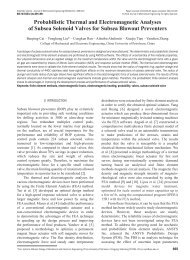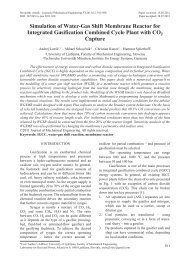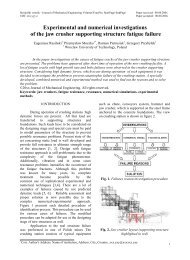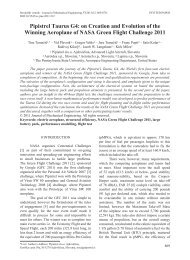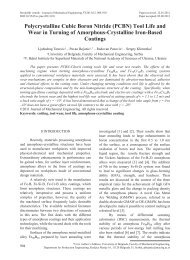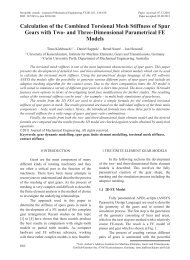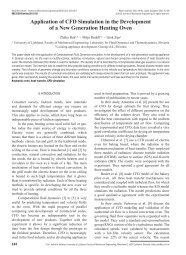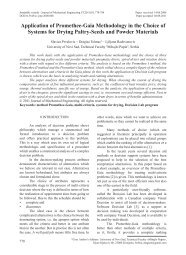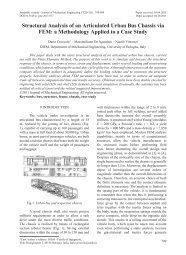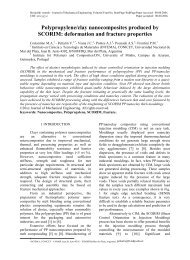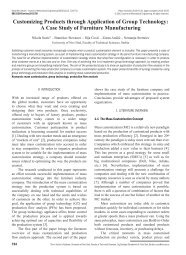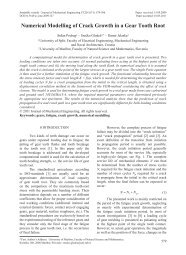Computation of Stress Intensity Factor in Functionally Graded Plates ...
Computation of Stress Intensity Factor in Functionally Graded Plates ...
Computation of Stress Intensity Factor in Functionally Graded Plates ...
You also want an ePaper? Increase the reach of your titles
YUMPU automatically turns print PDFs into web optimized ePapers that Google loves.
Strojniški vestnik - Journal <strong>of</strong> Mechanical Eng<strong>in</strong>eer<strong>in</strong>g 57(2011)7-8, 622-632whereK th* = M T · K th · M,C th* = M T · C th · M.(14a)(14b)The system <strong>of</strong> Eq. (13) conta<strong>in</strong>s N uncoupledequations,Λψii + siψi= ,( i = 12 , ,..., N),(15)*C iith* th*where s i = K ii / Ciiand Λ = M T (F th + F γth).The <strong>in</strong>itial condition ψ (0) can be obta<strong>in</strong>ed fromT(0) = M · ψ(0). Depend<strong>in</strong>g on the complexity <strong>of</strong>the right-hand side <strong>of</strong> Eq. (15), it is solved eitheranalytically or numerically.5 NUMERICAL RESULTS ANDDISSCUSSIONIn this section, the calculation <strong>of</strong> the mode ISIF for an edge crack <strong>in</strong> functionally graded plate(FGP) under thermal stresses is considered. Inaddition, a few parametric analyses are performedto study the effect <strong>of</strong> the gradation <strong>of</strong> materialproperties on the stress <strong>in</strong>tensity factor. Thedistribution <strong>of</strong> material properties is determ<strong>in</strong>edby means <strong>of</strong> cont<strong>in</strong>uum functions e.g., exponentialfunction or micromechanics models e.g., selfconsistentmodel. Examples are presented here:• An edge cracked plate: exponential gradation.• FGP with an edge crack: power law gradation.• Edge crack <strong>in</strong> an FGP: micromechanicsmodel.The FGP <strong>of</strong> length W and height H witha crack <strong>of</strong> length a, as depicted <strong>in</strong> Fig. 1a, isconsidered. The thickness (<strong>in</strong> the x 3 direction) <strong>of</strong>the plate is assumed to be quite th<strong>in</strong> for plane stressanalysis and large enough for plane stra<strong>in</strong> analysis.The crack is aligned parallel to the direction <strong>of</strong>material property gradation. Initially, the FGP is ata uniform stress-free temperature T 0 . Temperatures<strong>of</strong> x 1 = 0 and x 1 = W faces are decreased to constanttemperatures T 1 and T 2 , respectively. All otherfaces, <strong>in</strong>clud<strong>in</strong>g the crack surfaces, are assumed tobe <strong>in</strong>sulated, which results <strong>in</strong> a dimensional heatconduction problem <strong>in</strong> the x 1 direction. In all cases,the calculated SIFs will be normalized by divid<strong>in</strong>gto:K = E( 0) α( 0) T πa( 1−ν ( 0)).(16)0 05.1. An Edge Cracked Plate with ExponentiallyGradationFig. 1a shows an unconstra<strong>in</strong>ed FGP withan edge crack <strong>of</strong> length a, Fig. 1b presents thecomplete node arrangement <strong>of</strong> the FGP whichconsists <strong>of</strong> 1695 regular nodes and 40 crack-tipnodes, with a total <strong>of</strong> 1735. Fig. 1c shows thecrack-tip node arrangement. In this case, twodifferent types <strong>of</strong> functionally graded materialsare considered with exponentially vary<strong>in</strong>gthermomechanical properties (E, ν, α, k, ρc), <strong>in</strong> thex 1 direction, e.g.:Ex ( ) = E( 0)exp( P x ), (17)1 E 1where the nonhomogeniety parameters are def<strong>in</strong>ede.g., as:EWPE = 1 ⎛ ( ) ⎞ln ⎜ ⎟. (18)W ⎝ E( 0)⎠Fig. 1. An FGM plate with an edge crack;a) geometry, b) complete node arrangement, c)crack-tip node arrangementThe values <strong>of</strong> the nonhomogeneityparameters for the first material are selectedarbitrarily (academic materials) as they followto provide conditions for which the referencessolutions are available.E(0) = k(0) = α(0) = ρc(0) = 1.0, ν(0) = 0.3.For the second case, the ceramic/metalFGM ZrO 2 /Ti-6Al-4V material with properties <strong>of</strong>Table 1 is assumed.<strong>Computation</strong> <strong>of</strong> <strong>Stress</strong> <strong>Intensity</strong> <strong>Factor</strong> <strong>in</strong> <strong>Functionally</strong> <strong>Graded</strong> <strong>Plates</strong> under Thermal Shock625



